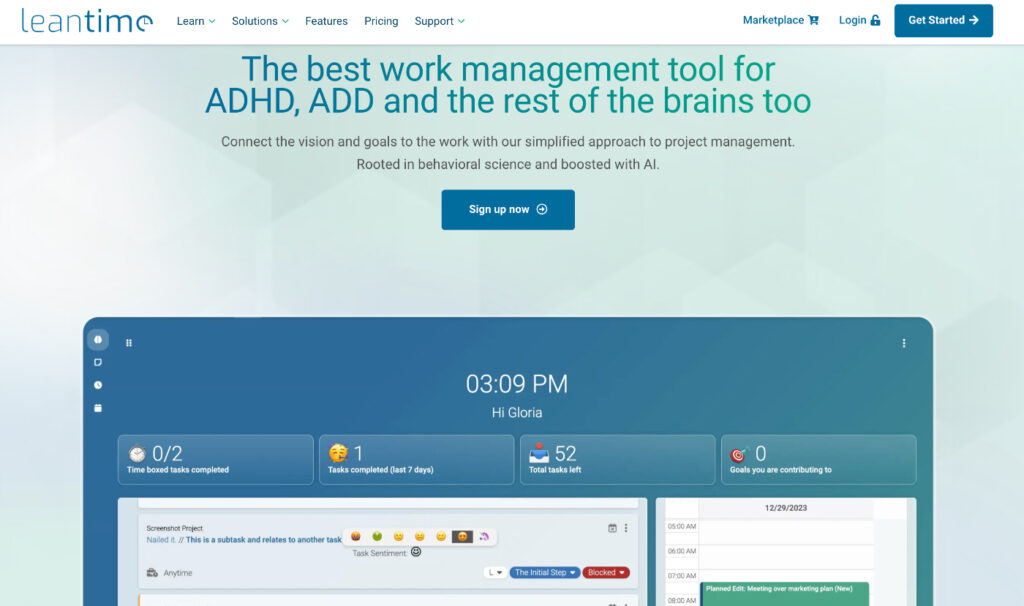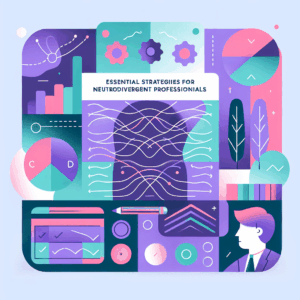Estimated reading time: 10 minutes
Managers and team leaders have to understand how crucial accommodating each team player is nowadays. However, workplace accommodations for ADHD aren’t available in some companies, causing employees with this condition to struggle.
One study showed that people with Attention Deficit Hyperactivity Disorder are 60% more likely to get fired, 30% more likely to have work issues, and three times more likely to quit impulsively. They will often make your company better as they are supported. It can’t just be on the employee to “figure it out,” and companies must respond to the call and support their ADHD co-workers.
Why is it important to have a workplace with ADHD accommodations, and how can companies do so? We dive deep into these questions in this article and provide solutions and ideas to help you support ADHD staff at work.
Table of contents
- Frequently Asked Questions
- ADHD Accommodations at Work
- Flexible Work Schedule
- Frequent Breaks
- Noise-Reducing Equipment and Quiet Workspace
- Clear Written Instructions
- Task Management Software
- Regular Feedback and Check-ins
- Physical Movement Opportunities
- Training and Skill Development
- Why Companies Shouldn’t Ignore ADHD
- Why Leantime is a Great Tool for People with ADHD
- Final Thoughts
ADHD Accommodations at Work

If you’re a company looking to provide reasonable accommodations, there are many you can implement easily. What workplace accommodations can you implement to help employees who struggle with ADHD?
Here are some reasonable accommodations that will help ADHD staff perform essential functions within the organization, followed by sample scenarios and implementation tips.
Flexible Work Schedule
One of the common ADHD symptoms is morning sluggishness. Coming to work at the standard 9 AM often means some might be less productive in the early hours.
Hence, a flexible work schedule can greatly affect workplace inclusivity.
Work Schedule Tips:
- • Allow them to start the workday later as long as they complete their work hours and deliverables.
- • Use tools like online calendars to keep track of varied schedules.
- • Ensure team communication is consistent so everyone is aware of availability.
Frequent Breaks
Let’s say you have a company copywriter named Emma, who finds she can focus intently for short bursts but then needs a mental break to recharge. Emma received an Attention Deficit Hyperactivity Disorder diagnosis early on.
One reasonable accommodation that could help Emma greatly is introducing frequent beaks so she can recharge between writing bursts.
Why Frequent Breaks:
- • Implement a method like the Pomodoro Technique, which involves focused work for 25 minutes followed by a 5-minute break.
- • Provide a quiet, designated break space.
- • Use timers or apps to remind employees when to take allotted breaks.
Noise-Reducing Equipment and Quiet Workspace
People with ADHD easily get distracted by office chatter and outside noise. As a result, there could be a drop in productivity among your coworkers with ADHD. What could help is to provide avenues with little to no distraction and to normalize that experience.
Read More: Boost Your Productivity with Effective Task Management Strategies
You can also provide accommodations for noise-reducing gear for all your staff. This will help your non-ADHD staff operate more efficiently in a private office and also not make them feel singled out.
Noise-Reducing Tips:
- • Provide noise-canceling headphones to help individuals stay focused
- • Designate a quiet workspace in the office or private area. This can lead to increased productivity.
- • Implement a policy of respecting quiet zones.
Clear Written Instructions
Someone with ADHD is prone to forgetting verbal instructions. That’s why it benefits them to have work tasks written down. Creating written instructions is a great practice to accommodate teams with ADHD workers better.
Written Instruction Tips:
- • Utilize tools like email, Slack, or Trello to communicate tasks.
- • Encourage managers to recap long meetings with written summaries.
- • Provide notebooks or digital note-taking tools.
Task Management Software
Keeping a mental note of tasks isn’t a strong suit for someone who struggles with ADHD forgetfulness. So, it’s likely that they will need a system in place to help document and monitor tasks.
The best software for this is task management software, which records tasks, detailed instructions, deadlines, and accountabilities.
Implementation Tips:
- • Implement task management software. We highly recommend Leantime because we created it with ADHD employees in mind.
- • Offer training sessions on how to use a task management tool.
- • Encourage team members to update tasks regularly.

Regular Feedback and Check-ins
Let’s think about another fictional employee with ADHD named Nina. She sometimes drifts off-course on projects without realizing she’s veering from the objective.
To help Nina, the human resources department should schedule regular feedback and check-in sessions to bring alignment and clarity. They don’t have to be long, but they must be consistent. Doing so will help bring better project alignment.
Some Feedback Tips:
- • Schedule regular one-on-one check-ins.
- • Use a positive and constructive approach to feedback.
- • Clearly outline expectations and any corrections needed.
Physical Movement Opportunities
Someone with ADHD often feels restless after sitting for long periods and finds movement helps their focus. So, creating a workspace and provisions within that environment to move can help accommodate them.
Some Implementation Tips:
- • Offer stand-up desks or adjustable workstations.
- • Encourage short walking breaks.
- • Consider incorporating “walking meetings” when feasible.
Training and Skill Development
Some might feel overwhelmed with new software because of their condition. They struggle to complete self-paced training materials and might feel frustrated when overcoming a learning curve.
Providing a varied approach to training people with ADHD could help build better workplace accommodations.
Don’t consider this as specialized training. Remember that everyone learns differently, and acknowledging that will help achieve a collective good for the company.
Some Training Tips:
- • Offer training sessions when your company introduces new tools and software.
- • Provide opportunities for employees to attend workshops or webinars.
- • Offer access to online courses and tutorials.
Time-Management Coaching
Time-management coaching helps employees with ADHD develop strategies to prioritize and organize tasks more effectively. A coach or mentor provides guidance on breaking large tasks into manageable steps, setting realistic goals, and using tools including Kanban Board, calendars, or to-do lists.
This support can include personalized techniques for staying on track, minimizing distractions, and maintaining a balanced workload. Employees can adjust their approach as needed, improving productivity and reducing stress.
Why Companies Shouldn’t Ignore ADHD
Attention Deficit Hyperactivity Disorder (ADHD) is a neurodevelopmental condition that affects millions of adults worldwide. Most people and organizations perceive it as a childhood disorder, but its implications continue into adulthood.
Recognizing the unique challenges faced by employees with ADHD allows organizations to unlock a reservoir of untapped potential.
Here are some benefits when you request accommodations for ADHD in your company.
- • Many with ADHD think outside the box, bringing novel solutions and fresh perspectives to problems.
- • When genuinely interested in one task, they can achieve intense periods of focus, often referred to as “hyperfocus,” allowing for deep work and rapid task completion.
- • There’s greater enthusiasm and drive in the right context, potentially boosting team morale.
- • Years of managing ADHD can often lead to a high degree of resilience.
- • Many with ADHD have strong intuitive skills that help them quickly size up situations or read between the lines.
- • Their brains often jump from one topic to another, making them versatile thinkers and potential multitaskers.
- • They may be more willing to take risks and discover innovative solutions or ventures others might not consider.
- • Challenges faced due to ADHD can enhance empathy and understanding toward others who face difficulties.
- • Their rapid thought processes can be advantageous in situations requiring quick thinking and adaptability.
- • It’s the law. Congress passed the Americans with Disabilities Act of 1990 to motivate companies to create reasonable accommodations for people with various disabilities, ADHD staff included.
But beyond what a company gets out of their employees with ADHD, they should also think about the ethical implications of promoting an inclusive workplace. Diversity in the workplace has become a center of gravity for many industries.
Inclusivity doesn’t stop with gender or race. It must also extend well into other considerations, such as mental health conditions. ADHD is one that many have pushed into the backburner for far too long. It’s time we started taking notice.
Why Leantime is a Great Tool for People with ADHD

For years, we wanted to find a work management solution to help organizations with ADHD. Typically, these tools are “individual” focused and missing the relevant work information to stay on track. Finding that balanced tool would give the more than 8 million adults in the US and millions worldwide a tool that empowers them.
That’s why we created Leantime, an assistive technology for ADHD staff. It’s a task and work management tool that helps ADHD employees in various ways. More specifically, it has provisions such as:
- • Multiple project views to fit one’s personal preferences
- • A distraction-free dashboard
- • Easy-to-understand Gantt Chart timelines
- • Helpful time management tools
- • Easy notes and reminders
- • AI-focused tools that help with ADD and ADHD
- • And more
But more than that, we focus on building intrinsic motivation by showcasing the goals, purpose, and relevance of the work each individual is doing. By creating this tool for companies with them in mind, we hope to promote more inclusive workplaces and allow people with ADHD to shine.
Leantime is also a great option for companies with staff who struggle with Dyslexia. We want to provide an open-source solution that all team members will appreciate, use, and maximize.
Leantime Believes Work Should be Personal
For people with ADHD, for example, it is hard to work on things that you don’t find interesting, don’t have value, or just don’t understand the why behind.
As these newer generations of workers come in, studies are supporting that millennials and Gen Z are looking for a purpose at work and want employers to align with their values.
Unfortunately, employers often struggle with communicating their why to the work and what they are focusing on. In fact, studies show that only 28% of middle managers and executives know their company’s strategies. This “why” is fundamental to engaging your employees in the work. Leantime brings this to the forefront through their focus on the individual contributor and building ways to showcase the company’s focus on the goals and how the tasks relate to it.
Leantime Features
Leantime is packed with useful features like role management, calendar integration, whiteboards, and a Kanban board to help streamline your projects. You’ll also find handy tools for time tracking, goal setting, and Gantt charts to keep everything on track.
With these and many other features, Leantime has everything you need to manage your projects smoothly. Check out all the features Leantime has to offer.
Final Thoughts
The key to greater inclusivity is not singling out and isolating an employee or group of employees. It’s to help everyone understand that we’re all different and promote a workplace that embraces that uniqueness.
Creating job accommodations for ADHD staff will be challenging, especially initially. But the rewards for them and the company will far outweigh the effort needed to implement these conditions.
Remember, ADHD affects each person differently. When employees with Attention Deficit Hyperactivity Disorder thrive and succeed, their colleagues and the entire company will also succeed. Valuing this collective win is key to becoming more progressive organizations that flourish in this new age.
If you have a question about workplace accommodations, you can always discuss it with your supervisor or project manager of the HR department.
Frequently Asked Questions
Here are some common accommodations that can help individuals with ADHD thrive in the workplace:
• Flexible Work Schedule
• Frequent Breaks
• Quiet Workplace or Workspace
• Task Management Training
• Designated Work Times
Yes. Employees with ADHD are protected under the Americans with Disabilities Act (ADA) and may request reasonable accommodations to perform their jobs effectively.
Yes, in most cases, you’ll need to disclose your diagnosis to HR to receive formal accommodations. However, you only need to share relevant information and can keep details about your treatment or medical history private.






